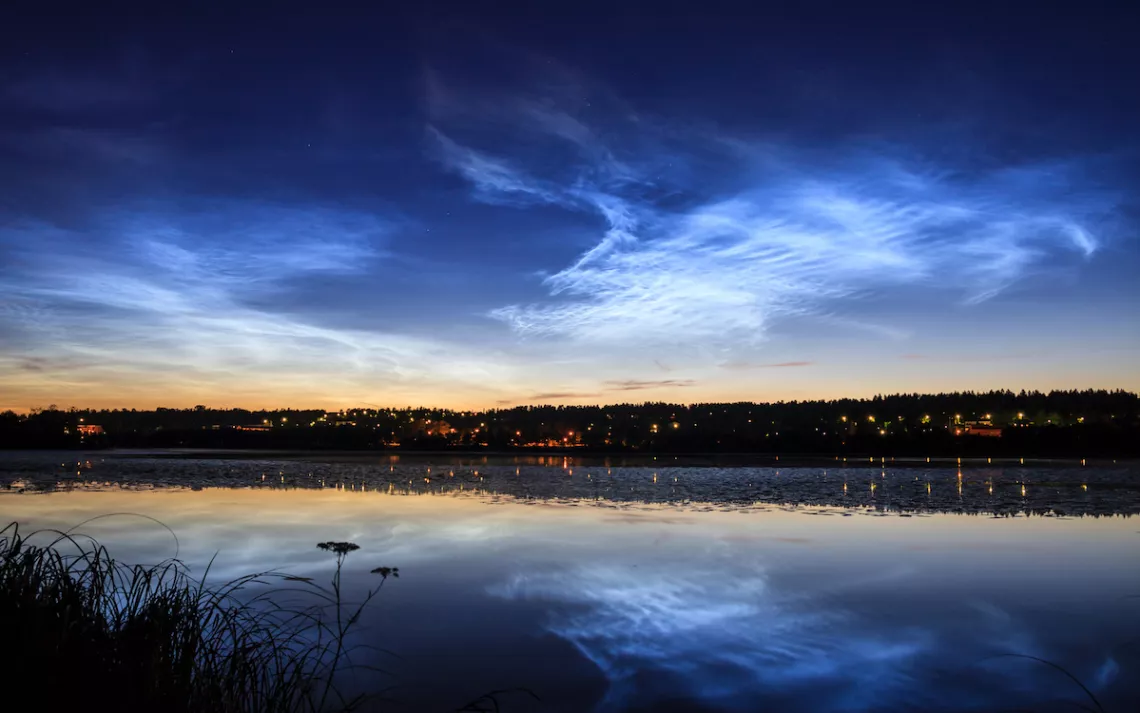July Astronomical Highlights: Noctilucent Clouds and the Summer Triangle
Fireworks aren’t the only show in the sky this month

Photo by Juhku/iStock
June and July are noctilucent cloud season, and June has already proven to be record-breaking this year. Noctilucent, or night-shining, clouds are high up in the mesosphere and shine by the light of the sun when it has already set below the horizon. The sun’s rays still reach into the highest edges of the atmosphere to light objects there. This is also how we can see satellites, with sunlight shining off them up in space even when it’s grown dark from our perspective on Earth.
Keep an eye out after dusk or before dawn to catch these ethereal, wispy, electric-blue clouds 50 miles above. Sometimes wavy or rippled noctilucent clouds give observers the feeling that they’re underwater looking up at the surface of the sea. This rare phenomenon was only first recorded in 1885 but has become a bit more common in recent years. On June 8, observers in Wisconsin reported seeing the clouds, and then on June 14 they were spotted as far south as Los Angeles.
The Summer Triangle and Double Stars
July is the time to revisit an old favorite: the Summer Triangle. The three stars that mark the corners of the triangle all come from different constellations, making the Summer Triangle one of the larger asterisms in the sky. The bright star closest to zenith (directly overhead) on July evenings is Vega in the constellation Lyra, one of the corners of the triangle. Use binoculars or a telescope to see how many double stars you can spot in Lyra.
To the northeast of Vega is the bright star Deneb in Cygnus, and to the southeast of Vega is the third corner of the triangle, Altair in Aquila. Near the center of this triangle is a star named Albireo, which marks the head of Cygnus the Swan. Albireo is a yellow-blue double star that is known as the prettiest pair in the heavens.
And while you are at it, don’t miss Delphinus, a favorite constellation that looks like a tiny dolphin leaping out of the water. It lies in the east, below the bottom line that makes up the triangle.
Planets and the Moon
Mercury, Venus, and Mars are quite close to the sun all month, making them too hard to spot. While you’re waiting for the sky to grow dark enough for fireworks on July 4, search the western horizon for a slender crescent moon, less than 8 percent illuminated. Mercury and Mars are to the moon’s lower right but will be lost in the glow of the recently set sun. To the moon’s upper left is the star Regulus in Leo the Lion, which should become visible in the darkening background as the fireworks display begins.
The moon passes the two largest outer planets midmonth. On July 13, the moon and Jupiter are about 4 degrees apart. On July 15, it’s Saturn that sidles up to the moon, within about 2 degrees. The next night is the full moon, on July 16 at 2:39 P.M. PDT, although it won’t rise above the horizon until the evening.
Total Solar Eclipse in South America
The first total solar eclipse since the one that crossed the United States in 2017 occurs on July 2 in the South Pacific, Chile, and Argentina. A partial lunar eclipse occurs on July 16, but almost all of North America is excluded from the view.
 The Magazine of The Sierra Club
The Magazine of The Sierra Club



